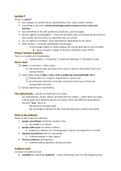Lecture 7
What is a genre?
➢ any category of content that is identified by: form, style, and/or function
➢ everything to do with a distinction/categorization based on form style and
function
➢ has something to do with audiences, producers, and messages
➢ tend to appear and disappear → they are not fixed, they can change all the time but
also maybe not since they are ingrained into our culture
➢ we, as audience members, have expectations depending on the genre
➢ 20th century→ no books specifically for teenagers
○ to encourage readers to keep reading, the young adult genre was invented
■ genre remains a staple of libraries and books since 1970s
Primary function of genres:
*give us a usable and recognizable:
1. categorization, 2. hierarchy, 3. (research) definition, 4. (research) scope
Genre: news
news is a narrative→ tells a story
the audience does not expect the news to tell lies and expect short and
concise stories
most media content tells a story with a patterned and predictable form
linking actions in a logical, sequential or causal way
providing the elements of people and places that have a fixed and
recognizable character
factual reporting vs. storytelling
The cultural texts→ genres are built into our culture
- our expectations, norms, values, are built into our culture→ when there are large
cultural gaps then different genres are used or there are different expectations
- the term “text” refers to:
- the physical message itself
- the meaningful outcome of the encounter between content and reader
What is the audience?
there are four types of audiences:
1. people assembled: proximity, location, time
a. eg. people in a lecture
2. people addressed: inscribed audience
a. people you address in a message (eg. a canvas message from a course)
3. happening audience: ad hoc/ impromptu
a. a demonstration in dam square
4. hearing audience: participatory
a. students asking questions during a lecture
Audience reach
concepts of audience reach:
● available (or potential) audience → least interesting since it is the biggest group
, ● attentive audience → pay attention
● interval audience → pay attention and internalizing message (they are thinking
about it)
● cumulative audience → indirect audience, indirectly, message goes further than
internal audience, directly, target audience might not be reached
● target audience → most expensive for advertisers since it is the desired one
Audience activity - competitor to the audience reach list (usually to talk about the price to
charge to the advertiser)
Biocca’s audience activity hierarchy
➔ selectivity
➔ resistance to influence
➔ utilitarianism (can you use the message?)
➔ intentionality
➔ involvement
Commercial audience activity hierarchy
➔ message offered
◆ eg. send 2000 letters
➔ message receivable
◆ eg. people move away, they do not receive it
➔ message received
◆ eg. letter is lost
➔ message registered
◆ eg. registered my persuasive message
➔ message internalized
➔ involvement
Three audience research traditions
, ★ structural tradition
○ define reach and social composition of audience, needed for media to sell ads
★ behavioral tradition- after WWI
○ early research preoccupied with media effects (persuasive powers), the
audience was conceptualized as passive recipients→ later research
considered the audience as more active
★ cultural tradition
○ considers media use as a reflection of a particular social-cultural context and
as a process of giving meaning to cultural products and experiences in
everyday life
Chapter 13
Media Genres, Formats and Texts
Questions of Genre
❖ genre-> a kind or type of text
➢ an emphasis on the genre tends to credit the value of a work to a cultural
tradition rather than to an individual artist
❖ Fiske (1987)- sees genre as a means of constructing the audience, in that appeal to
or within a certain genre or mic of genre elements produces a certain type of
audience with specific expectations and preferences
❖ Negus (1998)- work on genre reveals that
❖ genres are not just defined and classified by industries… audiences have their own
conception of genres as well
❖ genres overlap, and there are plenty of mixed genres and crossovers
❖ in the digital context, genres are defined by algorithis→ the results of such
algorithmic construction of product categories then get labeled, resulting in
‘hyperspecific’ micro genres that can be particular to individual users of the platform
❖ genre can refer to any category of content that has the following categories:
➢ its collective identity is recognized more or less equally by its producers
➢ this identity relates to purposes and form (length, pace, structure)
➢ the identity has been established over time and observes familiar
conventions; cultural forms are preserved, although these can also change
and develop within the framework of the original genre
❖ Andrew (1984)- genres construct the proper spectators for their own consumption
❖ Altman (1996)- three different roles that the notion of genre plays in media
production, content and reception
➢ genre provides a template for production decisions facilitating rapid delivery
products
➢ a genre offers a method of product differentiation and promotion as generic
identification





